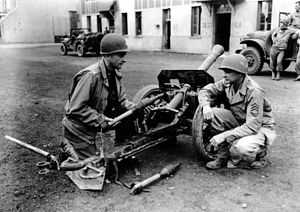8.8 cm Raketenwerfer 43
| 8.8 cm Raketenwerfer 43 | |
|---|---|
|
The 8.8 cm Raketenwerfer 43 and its ammunition being inspected by Allied troops. | |
| Type | Anti-tank rocket launcher |
| Place of origin | Nazi Germany |
| Service history | |
| In service | 1943–45 |
| Used by | Nazi Germany |
| Wars | World War II |
| Production history | |
| Number built | 3000 |
| Specifications | |
| Weight | 143 kg |
| Length | 2.972 m |
| Width | 1.016 m |
| Height | 0.899 m |
| Crew | 2 |
|
| |
| Caliber | 88 mm |
| Muzzle velocity | 140 m/s |
| Effective firing range | 350 m |
| Maximum firing range | 750 m |
The 8.8 cm Raketenwerfer 43 Puppchen[lower-alpha 1][1] was an 88 mm calibre reusable anti-tank rocket launcher developed by Nazi Germany during World War II.
It was given to infantry to bolster their anti-tank capability. The weapon was fired from a small two-wheeled gun carriage which fired a rocket-propelled, fin-stabilized grenade with a shaped charge warhead, similar to the grenade of the Panzerschreck but not the same. Approximately 3,000 units were completed from 1943 to 1945. It was made in much smaller numbers than either the Panzerschreck, which was based on the American Bazooka, or the Panzerfaust, which was a disposable rocket propelled grenade, firing a High Explosive Anti-Tank warhead. This is partly because it was realized that a simple hollow tube with an ignition device was all that was needed to launch the 88 mm rocket, rather than an elaborate miniature artillery piece with carriage and breech. Due to the carriage and better sights, the accuracy was better, and the range more than double that of the Panzerschreck.
See also
- Shoulder-launched missile weapon
- List of common World War II infantry weapons
Notes
External links
| Wikimedia Commons has media related to Raketen-Panzerbüchse 43. |
- http://www.lonesentry.com/articles/rocket/index.html
- http://vincesgallery.smugmug.com/gallery/1331090#62773580
References
- ↑ ""Puppchen" (auch "Püppchen" ? ) = 8,8cm Raketenwerfer 43, in Frankreich". Forum der Wehrmacht. Retrieved 19 April 2015.
| ||||||||||||||||||||||||||||||||||
